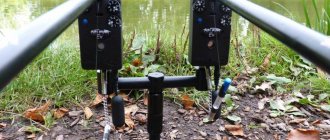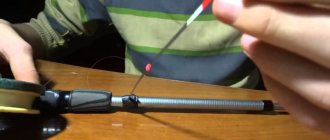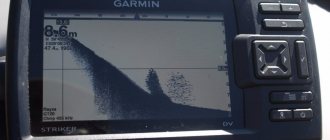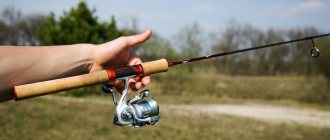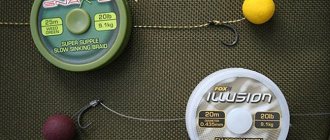Bite alarms are a real carp fishing float, which is responsible for indicating a bite and makes the only noise that brings joy to our hearts rather than irritation. The meaning of the alarm for carp fishing is that the fishing line is placed in a special roller. When a fish bites, the line begins to slide along the roller, causing it to spin, and from this rotation the alarm emits a sound signal. The faster the rotation, the more often the siren sounds. That’s why the term “locomotive” appeared - when the fishing line quickly runs along the roller and it squeals incessantly.
The electronic alarm is usually powered by a battery, usually a crown, AA or AAA, depending on the specific model. It has the ability to adjust the signal volume, and on advanced versions even the pitch and sensitivity. This is done so that by the sound you can determine which rod you need to hook. This is especially true in the dark.
However, one electronic alarm will not be enough. The fact is that the electronic alarm itself works well if the fish pulls the line from the shore, thereby giving it tension. If the carp bites towards the shore, then the line will sag and will not put any pressure on the roller at all. Accordingly, he will remain silent.
It is for such situations that mechanical alarms are used in combination with electronic ones. They are also convenient for adjusting the tension of the fishing line. Mechanical alarms are a real weight that hangs on a fishing line. At one end you get a sinker that you throw into the water, and at the other end there is a mechanical alarm. By winding the fishing line with a reel, you tighten the tackle; by releasing the fishing line, you loosen it. We will talk about the tension of the fishing line and how it affects the bite later.
Electronic signaling devices have a standard thread that fits any rack. For greater convenience, so as not to screw every time, you can purchase a special quick release. This is a two-part piece. You screw one into the rack, the other attaches to the alarm. And then you simply insert the one with the signaling device into the one that is screwed into the rack.
The mechanical signaling device is equipped with a special insert through which the electronic thread passes. You put the mechanical alarm on the thread of the electronic one, and screw the latter into the rack. Thus pressing the fasteners of the mechanical signaling device. It needs to be positioned so that it is parallel to the rod. After you have cast and placed the rod on the electronic indicator, you attach the mechanical one to the fishing line and begin to adjust the tension. After completely setting up the gear, turn on the electronic alarm. This will help you avoid unnecessary "peaks" that are completely useless. According to the unspoken etiquette of carp fishing, only the fish can make the alarms squeak, but not the angler.
Therefore, if you need to recast, turn off the alarms, and only then raise the rod. Of course, if there was a bite, we turn off the alarm before we put the rods back on the racks.
Pager. An excellent invention in which you can completely turn off the sound on the alarms and be guided only by the sound of the pager. Picks up a signal at a distance (on average about 100 meters, it all depends on the model). After simple manipulations, you connect the alarms to the pager and that’s it - you can sit quietly even in a closed tent, wait out the bad weather and drink hot tea. You also don’t have to worry that you won’t hear the alarms in your sleep – a pager is the best alarm clock, believe us!
How many alarms will I need?
Each working rod is a set of electronic and mechanical signaling devices. We strongly recommend that you don't try to get by with just one thing. We hope that we are writing this in vain and no one will think of fishing only with an electronic or only a mechanical one, but just in case - if you put only an electronic one, then when you bite “on the bank”, you can forget about the signal and timely hooking.
It simply won’t be there - the line will weaken, fall through and you will have to first reel in the slack and only then hook it. By this time, the fish will probably have gone into cover and a break will occur. If you install only a mechanical alarm, then you will have to turn into an owl for three days and stare at the fishing rods without stopping.
Vole alarms - mechanical
First of all, it is worth noting here (especially for beginning carp anglers) that in carp fishing, only the (mentioned above) electronic bite indicators are never (!) used. For carp fishing (when working with specific equipment for carp fishing), a “bundle” is always used: electronic + mechanical bite alarms.
And the main reason is that electronic models work perfectly only in cases when the fish (after biting) pulls the carp equipment in the direction “from the shore”.
If the carp follows sideways or “towards the shore”, then the fishing line will simply weaken or sag, thereby not affecting the roller or indicator sensor. And we, accordingly, will not hear anything. So, it is for this purpose that mechanical bite indicators exist, to a greater extent, acting as a “special weight” for tensioning the carp fishing line.
The main advantages of branded products
Of course, as a “weight” (for amateur fishing “for fun”) you can use homemade indicators made from ordinary clothespins, sticks (with a slot) or plasticine. And also, for example, buy mega-budget fishing bells. But they are definitely not suitable for serious carp fishing, as they have a LOT of shortcomings.
fishing bell on the feeder
The same cannot be said about modern/branded bite alarms (i.e., “store-bought”), which have such advantages as:
- convenient installation on carp fishing equipment (in particular, on stands for carp rods );
- the ability to quickly and effectively adjust the fishing line (depending on the specific conditions of carp fishing);
- the presence of LEDs (lighting up when bitten) or a special socket/mount for the “firefly”;
- guaranteed stability in windy weather and virtually instant dismantling (in case of a bite).
Naturally, there are a lot of other advantages introduced into ultra-modern products based on the many years of experience of their developers (part-time carp anglers).
Most popular varieties
Over the entire history of carp fishing, several versions of mechanical (visual) bite alarms have been developed. However, only 4 varieties turned out to be the most popular and practical: springers, “monkeys”, swingers and bats/hangers. But at the moment, the first 2 options have not survived the “race” and are practically not being produced. Since “climbing monkeys” (despite many advantages), they are still little/sensitive, and springers do not tension the line well, which makes them unsuitable for long-distance casting of equipment (or fishing for carp in a strong current).
In total, the best mechanical bite indicators turned out to be bats/hangers and swingers. What are they?
baht/hanger
Bats (or hangers)
Their basic design consists of a plastic (or metal) cylinder, on top of which there is a clip for fishing line (clips with “collars” or magnetized balls). And at the bottom there is a specially equipped mount for removable weights (actually, providing adjustment of line tension). Most often, the bats are attached to the stand itself (buzz bar or rod pod) using a chain. By the way, this is why they began to be called hangers (from the English word “hanger” - hanger, pendant).
This type of mechanical bite alarms is an ideal option for delicate (supersensitive) fishing for low-active carp on lakes or ponds (including pressed ones). Their only drawbacks are the not very fast and comfortable adjustment of the degree of line tension and a lot of idle indications in windy weather.
swinger
Swingers
Unlike bahts, they work normally even with strong gusts of wind. And, despite the lower sensitivity, they are extremely convenient in terms of adjusting the line tension. For this purpose, just move the weight on the metal “leg”. Those. a solid steel rod, one end of which is bent in the shape of a “leg” and is “hinged” connected to a plastic mount (in the form of a lever) on a buzz bar or rod-pod. And at the other end there is a clip (with antennae, legs, brackets or arms), respectively, for attaching this entire structure to the fishing line.
In some models of swingers for catching carp in strong currents or at ultra-long distances, a special spring (also adjustable) is provided for additional line tension. Another advantage of modern swingers is the presence of light indication (using a “connection” to an electronic signaling device). Thus, in the dark, you will be able to recognize a bite “from shore” or “to shore” by the different colors of LED flashing.
Prices for alarms
Electronic signaling devices. So, alarms, like fishing rods, are divided into three budget segments. Budget models are, as a rule, the simplest alarms, in which there is only one setting - the volume of the signal. Sometimes you can’t even connect a pager to them. But they are really inexpensive. The best option for beginners is definitely the FOX Mini Micron. It is quite inexpensive, yet it is completely sealed and can withstand any rain or cold.
You can also purchase a set of alarms with a pager. If your rods are located far away, a pager is very useful in such situations. If you go to the same body of water and always stay near the drains, then you can do without a pager. Here the choice is yours.
Also in the segment of budget signaling devices, the JRC RADAR CX Multicolor model deserves close attention. Although they are in the mid-priced range, the alarms have undergone a full cycle of preliminary testing in the UK. This is a complete set of bite indicators for modern carp fishing!
If we continue the conversation about available alarms, then it is simply impossible not to mention the model from Carp Spirit “Blax Alarm“. A real workhorse at a very affordable price. This is a real find for amateurs and beginners!
One of the latest innovations that the carp equipment market offers is the FOX RX+ alarms. They replaced the top-of-the-line NTXr+ and introduced the world to a much wider range of capabilities. Incredible sensitivity, which literally reacts to the movement of the fishing line in a matter of millimeters, while you can also set a much less sensitive mode. The pager has a “night mode” that will respond to all bites, but will not disturb the angler’s sleep over trifles.
Mechanical alarms. Everything is simple here. The world of mechanical signaling devices has changed since the release of the FOX Black Label Bobin. This series is a real constructor that allows you to instantly adapt to wind, zig-rig, long and short fishing distances without any extra effort. Read the full review here. We talk in detail about the advantages of this series and the rules for using all components.
The Korda company has also prepared a very interesting model. They offered anglers universal signaling devices that are suitable for fishing close to the shore, with a weakened fishing line. At the same time, if you put a heavy sinker, then it is quite possible to fish at long ranges, but it is their work at “amateur” distances that makes them so popular among amateur fishermen.
Subsequently, FOX introduced an updated line of mechanical alarms, adding the Dumpy Bobbin and Stealth Bobbin models. We also wrote a long and detailed review about them.
In general, mechanical alarms are divided into “swingers” and “bats”. Bats are two balls, between which a fishing line with a chain clings. Swingers are a metal leg and a special lock that hangs on a fishing line. Bats are more delicate, but are subject to strong fluctuations during the wind. Swingers are heavier and put more tension on the line. Therefore, previously it was necessary to have both types of alarms in the arsenal in order to adjust the gear to certain conditions at the right time. With the release of Black Label this went away.
Which bite alarm is best to choose when fishing for carp?
Experienced carp anglers most often use several alarms of different types at the same time - both mechanical and electronic. The need for an electronic detector is determined, first of all, by the duration of carp fishing and the actual wait for a bite.
While a mechanical one can sometimes serve other than its intended purpose. When fishing for carp, the sinker is often mounted in a blind way in the hope that the fish will hook itself. In this case, a heavy mechanical device will act in a non-standard role as a line tension regulator.
Selection of alarms
Of course, first of all, you should start from your budget. The best option is to buy alarms as a set. This way they will be much cheaper than purchasing four alarms and a separate pager separately. Currently, in stores you can always purchase “3+1” (3 alarms and 1 pager) or “4+1” (4 alarms and 1 pager) sets. All sets are supplied in protective cases, which is also a big plus - it’s convenient to store them after fishing.
The same applies to mechanical alarms, although they are much cheaper than electronic ones, and this is quite logical.
Based on companies, we would recommend the FOX Mini Micron series for beginners. You can save a lot on a pager, but if you can buy one, that’s great. We have used different models from FOX and can confidently say that these are top quality products, which, in principle, solve the problem of choosing alarms forever.
How to configure alarms correctly?
The logic is as follows. The further the fishing distance, the stronger the line tension. The closer the fishing distance, the weaker the line tension. When fishing with a zig-rig, a strong line tension is required.
In general, regarding the dependence of line tension (setting up alarms), there is a wonderful guide from Rob Hughes, which has been tested for years, and from which you can safely build on.
- Fishing near the shore, at any depth - low tension
- Fishing at medium distance (up to 60m-90m), at any depth - medium tension
- Long-distance fishing, as well as fishing at any distance with obstacles (grass, algae) - strong tension
Below are pictures, from left to right: medium and high tension. The pictures are guidelines rather than strict illustrations. There is no need to measure the height of the signaling devices on them down to the centimeter. This is rather just a demonstration so that you have something to start from. With a weak tension, the mechanical signaling devices are strongly lowered down to the ground.
Why do you need to vary the line tension? If you are fishing at a long distance, then slack line can prevent the alarm from detecting a bite, since it neutralizes the movement of the line. Roughly speaking, not the whole line will move, but only some part of it. When fishing close, on a shorter piece of fishing line, medium tension is quite enough. Moreover, near the shore, a fishing line stretched like a string will scare away the fish.
Main types
Pendulum
One of the types of visual mechanical signaling devices.
By its design, it is a plastic tube with a wire inside and two rings through which the fishing line passes. To visually detect a bite, the device is equipped with a bright head into which a firefly can be inserted at night. The bite signal is produced by deflecting the tube from a vertical position and further swinging it like a pendulum.
The inconvenience of using this type of detector in conditions of strong wind or current, which can provoke a false signal, dictates the basic rules for choosing the size of this device :
- A small pendulum alarm .
- A heavy and large mechanism will be more effective when fishing in strong wind conditions .
The beginning of a bite is signaled by a slight vibration of the pendulum. The continuation is followed by a smooth movement of the mechanism, indicating the moment of tension of the fishing line, the most successful for hooking. Single movements, albeit with a significant deviation of the tube, most often are not a sign of a bite, but arise as a result of touching the fishing line or feeder.
Sound
The simplest representative of this type of device is a bell, equipped with a clamp for attachment to the tip of the fishing rod. However, let us dwell in more detail on electronic signaling devices, most of which are equipped with an audible signal.
As emphasized earlier, the most advanced models have the ability to customize the sound signal depending on various criteria. For example, the simplest thing is that the tone of the sound alert coming from each of several rods may differ. In addition, the sound may vary depending on the tension of the line.
Light
This signaling device consists of a luminous element that must be attached to the tip of the fishing rod. The service life of this type of device varies from an hour to several years.
The main disadvantage of light detectors is their dependence on the sensitivity of the rod tip. However, there are also designs that respond to line tension - their sensitivity is more acceptable.
The higher the intensity of the luminescent substance, the longer and more effective the use of the light bite alarm. For lovers of night fishing, it makes sense to purchase an indicator with the characteristics of a substance of 500-600 microlambert.
Swinger
One of the most popular types of mechanical alarms is the swinger. Its mechanism consists of:
- a plastic head with a clamp through which the fishing line is pulled;
- lever with weight;
- hinged device for mounting on the rod stand bracket.
The tension of the fishing line is controlled by placing a weight in one or another part of the lever. The closer the load is to the head, the stronger the tension. The bite signal is determined visually by the movement of the swinger head.
Most often, swingers are used for bottom fishing and carp fishing.
Transportation and storage of alarms
If you buy alarms as a set, you will receive a convenient storage case for free. If you buy alarms separately, then you should think about where you will store them. An alternative is to leave them on the buzz bars and put them in the buzz bar storage bag. There is also a pocket for mechanical alarms. It is better to take good care of this, because the protective case in which the alarms are sold can rather be regarded as external protection. Under serious loads, it is unlikely to save.

